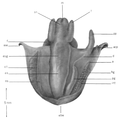Abyssochrysos melanioides
| Abyssochrysos melanioides | |
|---|---|

| |
| anatomy of Abyssochrysos melanioides removed from the shell | |
| Scientific classification | |
| Domain: | Eukaryota |
| Kingdom: | Animalia |
| Phylum: | Mollusca |
| Class: | Gastropoda |
| Subclass: | Caenogastropoda |
| Family: | Abyssochrysidae |
| Genus: | Abyssochrysos |
| Species: | A. melanioides
|
| Binomial name | |
| Abyssochrysos melanioides | |
Abyssochrysos melanioides is a species of sea snail, a marine gastropod mollusk in the family Abyssochrysidae.[2]
This is the type specimen for which Tomlin created a new family Abyssochrisidae, but couldn't refer at the time to any superfamily. Some years later he thought it had any affinities with the families Littorinidae Children, 1834 and Thiaridae Gill, 1871 (1823).[3] Houbrick (1979) brought the then known species of Abyssochrysos in the superfamily Loxonematacea Koken, with close affinities to the families Zygopleuridae Wenz, 1939, Paleozygopleuridae Horny, and Pseudozygopleuridae Knight, 1930.[4]
Distribution[edit]
- The type specimen was dredged from a depth of 1645 m to 1828 m off the Cape of Good Hope, South Africa.
- Philippines[5]
- Indonesia[5]
Description[edit]
-
anatomy
References[edit]
- ^ Tomlin J. (1927). "Reports on the Marine Mollusca in the Collections of the South African Museum, II: Families Abyssochrysidae, Oocorythidae, Haliotidae, Tonnidae". Annals of the South African Museum 25(1): 77–83, 4 figures.
- ^ Abyssochrysos melanioides Tomlin, 1927. Retrieved through: World Register of Marine Species on 5 May 2010.
- ^ Tomlin (1931), On South African Marine Mollusca, with Descriptions of New Genera and Species. Annals of the Natal Museum, 6(3): 415–450, plate33
- ^ R.S. 1979. Classification and systematic relationships of the Abyssochrysidae, a relict family of bathyal snails (Prosobranchia; Gastropoda). Smithsonian Contributions to Zoology 290: 1–21
- ^ a b Bouchet P. (1991). "New records and new species of Abyssochrysos (Mollusca, Caenogastropoda). Journal of Natural History 25(2): 305–313. doi:10.1080/00222939100770221.




